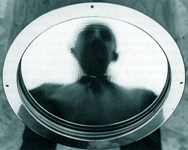CongressCATH 2005 | Ethics and Politics of Virtuality and
Indexicality

“Virtual Money: Data Visualisation and Financial Capitalism”
by Rita Raley
Abstract: This
paper takes as its theme the aesthetic visualization of the operations
of financial capitalism, primarily addressing the computer art project
by Joshua Portway and Lisa Autogena: Black Shoals Stock Market
Planetarium (Tate 2001; Copenhagen 2004). Deriving its title from Myron
Scholes’s and Robert Merton’s formula for pricing derivatives, Black
Shoals uses real-time financial data to thematize the market as a
complex adaptive system. In its use of ALife creatures within the
economic-aesthetic environment, this project closely resembles John
Klima’s ecosystm (2001), which generates a simulated ecosystem out of
real -time currency exchange rates. Similarly, Laura Kurgan’s Global
Clock No.1 (2000) and Global Clock No.2 (2002) provide a temporal
interface for real-time currency exchange rates of the dollar, euro, and
yen. Using a Reuters data feed, Kurgan’s clock visualizes the movements
(exchanges and value) of money and investigates “the luminous
immateriality of money and its mutable media.” All of these data
visualization projects reflect the abstraction of form inherent in
networked financial exchanges, particularly in the case of derivatives.
Such data visualization projects thus invite certain questions: How can
one use data maps and visualizations to think about causes and material
effects? In a data visualization project, especially with the data that
of global finance, what aesthetic does one produce? Is it simply
replicatory or reiterative of the logic of financial capitalism and of
neoliberal globalization? What is the relation, further between these
new media representations of capital and the use of banknotes and coins
in the artwork of Warhol, Beuys, Otis Kaye, and Paolo Monti? How
would the issues of reference, abstraction, and materiality differ? How
might these data visualization projects help us to consider the
relations between materiality and abstraction not in terms of a
historical progression (with money becoming dematerialized and abstract
in the passage from gold to notes to digital bits) but in terms of
parallax? The aesthetic of Black Shoals, in other words, must be
understood to be grounded in the material realities of global
capitalism.
 Virtual
Money: Data Visualisation and Financial Capitalism Virtual
Money: Data Visualisation and Financial Capitalism
Author: Rita Raley, University of California, Santa Barbara.
Panel: Archive, Friday 1 July, 11.00 - 12.30.
|

